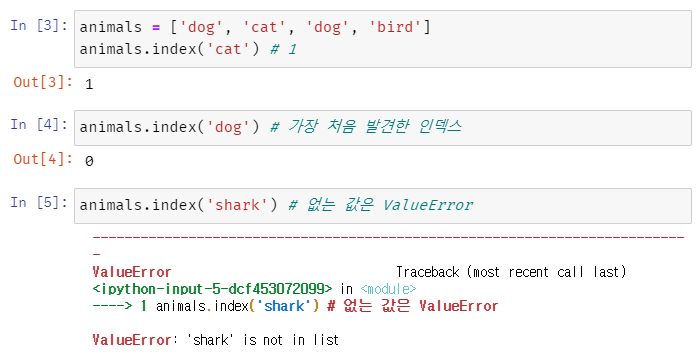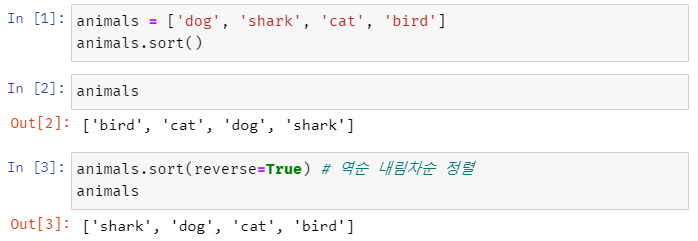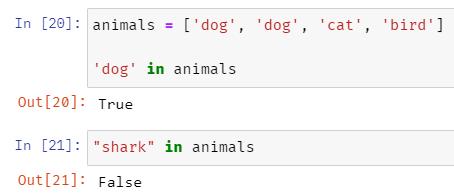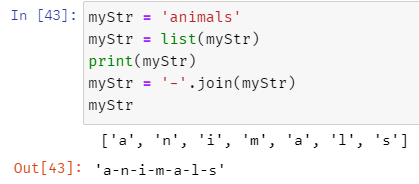파이썬 리스트 관련 함수
.index(value)
list 안에 value 값이 있으면 해당 value 값의 index를 반환한다.
만약 찾는 value 값이 여러 개 있는 경우 가장 처음에 발견한 데이터의 index 값을 반환한다.
찾는 value 값이 없다면 ValueError가 발생한다.

.remove(value)
특정 value 값을 가진 원소를 삭제한다.
같은 value가 여러 개 있다면 첫 번째로 찾은 원소만 삭제한다.
찾는 value 값이 없다면 ValueError가 발생한다.

.pop()
list 맨 뒤에 위치한 원소를 반환하고, 해당 값을 list에서 제거한다.
매개변수를 넣어 해당 index의 원소를 pop 할 수도 있다.

.sort()
list 원소들을 정렬하는 함수이다.
기본으로는 오름차순 정렬이고, 매개변수 값 reverse를 True로 설정하는 경우 내림차순 정렬도 가능하다.

.reverse()
리스트의 원소 값들을 반대로 뒤집는 함수이다.

sorted()와 list
sorted() 함수에 들어가는 매개변수 값은 아래와 같다.
sorted(iterable, key=key, reverse=reverse)
iterable은 sort 대상이 되는 것이다. (list, dict, tuple 등)
key는 대소 비교를 하는 함수로 디폴트 값은 None이다.
reverse는 오름차순인지 내림차순인지를 결정하는 것이다. 기본 값은 False인데 이건 오름차순 정렬이라는 뜻이고, True는 내림차순 정렬이라는 뜻이다.

sorted() 함수는 원본 변경을 하지 않으므로 sorted(list) 한 결과 값을 반환한다.
in 연산자와 list
찾는 값이 list 내에 있으면 True를 반환하고, 없으면 False를 반환한다.

list와 str
join()
list 내 원소 값들을 합쳐서 하나의 문자열로 만들 수 있다.

현재 join() 함수는 animals list내에 있는 원소들을 - 문자로 연결시킨다.
연결시키려는 문자 값은 사용자가 원하는 값을 지정하면 된다.
빈 문자도 가능하고, 공백도 가능하고 다른 문자열도 가능하다.

split()
문자열 값을 쪼개어 쪼갠 것들 각각을 list 원소로 저장한다.

위 join()에서 In [48] 부분에 result 변수에 dog-shark-cat-bird 문자열 값을 저장하였다.
그 문자열을 -를 기준으로 쪼개어 list로 저장한 것이다.
매개변수 값이 없는 경우 공백을 기준으로 쪼갠다.

형 변환 함수 list(str) str -> list

문자열 값을 형변환 함수 list()를 이용해 리스트로 만들었다.

응용하여 문자열 animals를 a-n-i-m-a-l-s로 변경해보았다.
list 함수 정리
append() Adds an element at the end of the list
clear() Removes all the elements from the list
copy() Returns a copy of the list
count() Returns the number of elements with the specified value
extend() Add the elements of a list (or any iterable), to the end of the current list
index() Returns the index of the first element with the specified value
insert() Adds an element at the specified position
pop() Removes the element at the specified position
remove() Removes the first item with the specified value
reverse() Reverses the order of the list
sort() Sorts the list
